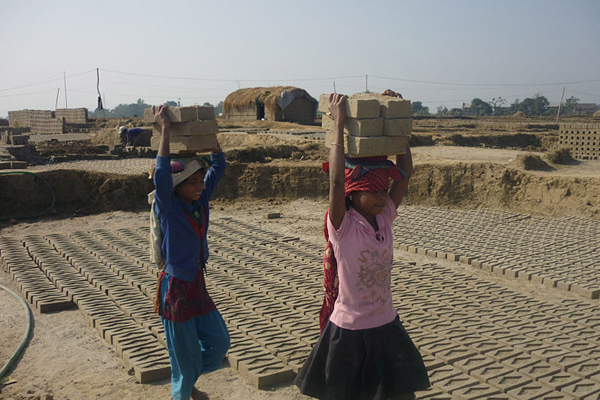CLIMATE CHANGE-INDUCED HEAT RISKS FOR MIGRANT POPULATIONS WORKING AT BRICK KILNS
|
CLIMATE CHANGE-INDUCED HEAT RISKS FOR MIGRANT POPULATIONS WORKING AT BRICK KILNS India is experiencing increasing heat both in the economy and in rising temperatures. The people suffering the most from actual heat, such as rural populations and migrant daily wage laborers, are to a large degree left out of by globalization and neoliberal capitalism while still bearing the brunt of its negative consequences. The structural adjustment programmes (SAPs) launched in the early 1990s led India into a new economic era and transnational corporation export-oriented growth that has mainly manifested in its cities, widening the inequality gap between rural and urban populations. One consequence of this is a booming building industry that drives demand for clay bricks from brick kilns that employ rural migrant labor. Here, we find two sides of India emerging as the paradox of a building technology shaping the new while still based on ancient techniques of fired soil and human labor. Hence, at one extreme, new high-rise buildings are hosting busy modern life of people from India’s growing middle class, working for global companies and cooled down by air conditioning. At the same time, India’s local economy long nurtured by rural village farming populations found themselves falling into increasingly precarious circumstances, forced off the land, often due to mounting debts, and into the migrant working force with many ending up at brick kilns. Generally, the most vulnerable populations, such as migrant workers and the elderly, have borne the unjust burden of climate change consequences. The negative impact of the SAPs on agricultural policies for rural labor, combined with climate change-driven factors that have worsened the dry season, has forced rural populations and landless migrant workers to travel from the poorest of Indian states, such as Bihar, Orissa, Uttar Pradesh, and West Bengal, into low-tech jobs, such as brick making. The brick kiln sector in India employs millions of migrant workers. Though now illegal in India, various forms of bonded labor that amount to essentially forms of slavery, including child labor, continue to be common practice throughout India’s brick industry due to weak law enforcement. Families, including young children, work in harsh, low-paying conditions, commonly compensated piece by piece. There is typically a lack of basic facilities, such as access to clean drinking water and sanitation. Risks to health are many and the sector has high death rates. Health impacts mainly originate from breathing in smoke and physically demanding work outdoors combined with extreme weather causing heat strain and other illnesses such as pneumonia and respiratory infections. Long-term brick kiln workers, who adopt a specific posture for prolonged working periods, commonly develop severe musculoskeletal problems. The main raw materials used for brick kiln production are soil and coal. A study from Bihar showed that as much as 90% of the soil used for brick production in the state was procured from agricultural land, and if kept in agricultural production, this land could have produced 7000 t of rice, enough to keep 110,000 people with food grain. Given that a large portion of the brick kiln workers in large cities, such as Chennai, migrate from Bihar, one of the poorest states, it indicates another one of the tragic loops that drives the system. Black carbon/soot still furthers the negative loops and necessitating migration as it heats up the atmosphere and thus accelerates the melting of Himalayan glaciers that feed India’s large rivers. Most brick kiln workers do, however, maintain their linkage to their original place of residence, engaging in a form of circular migration where farm work and unorganized work at the brick kiln supplement each other as sources of livelihood for rural poor such as landless laborers and marginal farmers. They migrate for the brick kilns during the dry season when there is not much work in agriculture and return to their villages at the start of the monsoon. They are contracted to the kiln industry in their villages by a local contractor who will know which people are in need of loans and extra livelihood and thus willing to migrate. The contractor gets a commission from the number of bricks made by the worker supplied by him. The lure is the lump sum the worker gets in advance and which the family can use for paying back debts and buying foodstuff during an otherwise lean period. He and any accompanying family are then bonded to work in order to pay back the advance. Source: https://www.ncbi.nlm.nih.gov/pmc/articles/PMC5854725/ |



